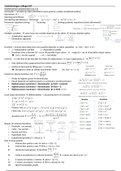Samenvatting
Samenvatting Introduction to Computational Thinking - Minor BFW
Samenvatting voor het tentamen van de colleges van het minor vak 'Introduction to Computational Thinking'. Deze samenvatting is in het Engels. Tip: oefen ook veel. Oefententamen was representatief voor het tentamen.
[Meer zien]




